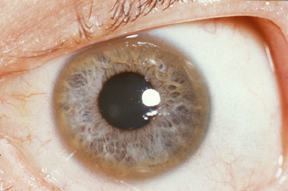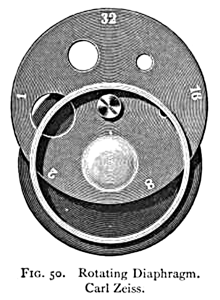
The lens is a transparent biconvex structure in the eye that, along with the cornea, helps to refract light to be focused on the retina. By changing shape, it functions to change the focal length of the eye so that it can focus on objects at various distances, thus allowing a sharp real image of the object of interest to be formed on the retina. This adjustment of the lens is known as accommodation. Accommodation is similar to the focusing of a photographic camera via movement of its lenses. The lens is more flat on its anterior side than on its posterior side.

Eye surgery, also known as ocular surgery, is surgery performed on the eye or its adnexa, typically by an ophthalmologist. The eye is a very fragile organ, and requires extreme care before, during, and after a surgical procedure to minimise or prevent further damage. An expert eye surgeon is responsible for selecting the appropriate surgical procedure for the patient, and for taking the necessary safety precautions. Mentions of eye surgery can be found in several ancient texts dating back as early as 1800 BC, with cataract treatment starting in the fifth century BC. Today it continues to be a widely practiced type of surgery, having developed various techniques for treating eye problems.

The aqueous humour is a transparent watery fluid similar to plasma, but containing low protein concentrations. It is secreted from the Ciliary body, a structure supporting the lens. It fills both the anterior and the posterior chambers of the eye, and is not to be confused with the vitreous humour, which is located in the space between the lens and the retina, also known as the posterior cavity or vitreous chamber.

Intraocular lens (IOL) is a lens implanted in the eye as part of a treatment for cataracts or myopia. The most common type of IOL is the pseudophakic IOL. These are implanted during cataract surgery, after the cloudy eye's natural lens has been removed. The pseudophakic IOL provides the same light focusing function as the natural crystalline lens. The second type of IOL, more commonly known as a phakic intraocular lens (PIOL), is a lens which is placed over the existing natural lens and is used in refractive surgery to change the eye's optical power as a treatment for myopia (nearsightedness).

Kayser–Fleischer ring are dark rings that appear to encircle the iris of the eye. They are due to copper deposition in part of the cornea as a result of particular liver diseases. They are named after German ophthalmologists Bernhard Kayser and Bruno Fleischer who first described them in 1902 and 1903. Initially thought to be due to the accumulation of silver, they were first demonstrated to contain copper in 1934.

Eye color is a polygenic phenotypic character determined by two distinct factors: the pigmentation of the eye's iris and the frequency-dependence of the scattering of light by the turbid medium in the stroma of the iris.

The ciliary body is a part of the eye that includes the ciliary muscle, which controls the shape of the lens, and the ciliary epithelium, which produces the aqueous humor. The aqueous humor is produced in the non-pigmented portion of the ciliary body. The ciliary body is part of the uvea, the layer of tissue that delivers oxygen and nutrients to the eye tissues. The ciliary body joins the ora serrata of the choroid to the root of the iris.

Cataract surgery, also called lens replacement surgery, is the removal of the natural lens of the eye that has developed an opacification, which is referred to as a cataract, and its replacement with an intraocular lens. Metabolic changes of the crystalline lens fibers over time lead to the development of the cataract, causing impairment or loss of vision. Some infants are born with congenital cataracts, and certain environmental factors may also lead to cataract formation. Early symptoms may include strong glare from lights and small light sources at night, and reduced acuity at low light levels.

In optics, a diaphragm is a thin opaque structure with an opening (aperture) at its center. The role of the diaphragm is to stop the passage of light, except for the light passing through the aperture. Thus it is also called a stop. The diaphragm is placed in the light path of a lens or objective, and the size of the aperture regulates the amount of light that passes through the lens. The centre of the diaphragm's aperture coincides with the optical axis of the lens system.

The ciliary muscle is a ring of smooth muscle in the eye's middle layer that controls accommodation for viewing objects at varying distances and regulates the flow of aqueous humor into Schlemm's canal. It changes the shape of the lens within the eye, not the size of the pupil which is carried out by the sphincter pupillae muscle and dilator pupillae.
Hemeralopia is the inability to see clearly in bright light and is the exact opposite of nyctalopia, the inability to see clearly in low light. Hemera was the Greek goddess of day, and Nyx was the goddess of night. However, it has been used in an opposite sense by many non-English-speaking doctors. It can be described as insufficient adaptation to bright light. It is also called "heliophobia" and "day blindness".
Aphakia is the absence of the lens of the eye, due to surgical removal, such as in cataract surgery, a perforating wound or ulcer, or congenital anomaly. It causes a loss of accommodation, high degree of farsightedness (hyperopia), and a deep anterior chamber. Complications include detachment of the vitreous or retina, and glaucoma.

The zonule of Zinn is a ring of fibrous strands forming a zonule that connects the ciliary body with the crystalline lens of the eye. These fibers are sometimes collectively referred to as the suspensory ligaments of the lens, as they act like suspensory ligaments.

The posterior chamber is a narrow space behind the peripheral part of the iris, and in front of the suspensory ligament of the lens and the ciliary processes. The posterior chamber consists of small space directly posterior to the iris but anterior to the lens. The posterior chamber is part of the anterior segment and should not be confused with the vitreous chamber.
A circle contact lens, also known as a big eye contact lens and circle lens, is a cosmetic contact lens that makes the eye's iris appear larger. It has become a trend throughout East, South and Southeast Asia and is largely produced in Japan, South Korea and China.

A limbal ring is a dark ring around the iris of the eye, where the sclera meets the cornea. It is a dark-colored manifestation of the corneal limbus resulting from optical properties of the region. The appearance and visibility of the limbal ring can be negatively affected by a variety of medical conditions concerning the peripheral cornea. It has been suggested that limbal ring thickness may correlate with health or youthfulness and may contribute to facial attractiveness. Some contact lenses are colored to simulate limbal rings.

Glassblower's cataracts are a form of cataract due to an occupational exposure. They are formed by many years or decades of exposure to infrared radiation while working in the occupation of glass blowing, or working close to hot or molten metals such with metal foundry workers or blacksmiths. Glassblower's cataracts are due to chronic exposure to infrared radiation emitted due to the extreme heating of glass or molten metal. The infrared radiation is absorbed by the iris and lens of the eye. This causes cataracts after decades of exposure. This condition may be prevented by wearing protective glasses while practicing these occupations.
IOL Scaffold or Intraocular lens Scaffold technique is a surgical procedure in Ophthalmology. In cases where the lens bag is ruptured and the cataract of the eye is not yet removed one can inject an artificial lens or Intraocular lens (IOL) inside the eye under the cataract. This way the IOL acts as a scaffold and prevents the cataract pieces from falling inside the eye. One can then remove the cataract pieces safely by emulsifying it with ultrasound. This technique is called IOL Scaffold and was started by Dr. Amar Agarwal from Chennai, India at Dr. Agarwal's Eye Hospital.
Adolf Vossius was a German ophthalmologist.










